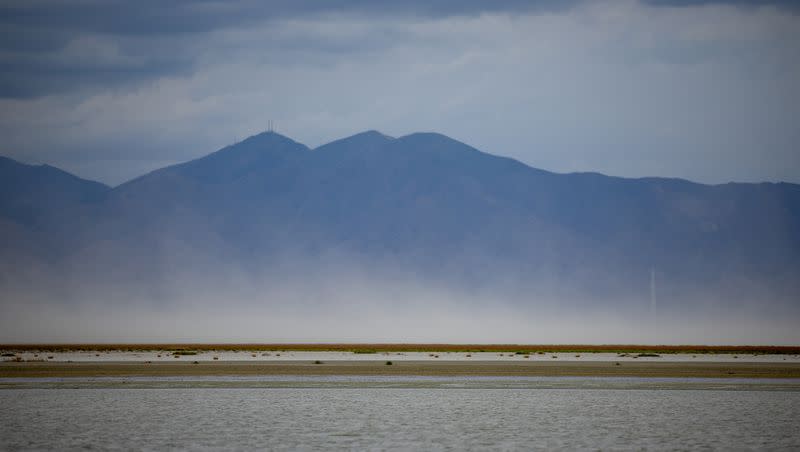University of Utah study: Great Salt Lake dust on snow helped hasten melt 17 days early

The highest snowpack dust concentrations in 13 years at an Alta study site were recorded in 2022, accelerating snowmelt by 17 days — and dry beds at the Great Salt Lake were the chief culprit in terms of the widespread nature of the dust.
A study published Thursday in the journal Environmental Research Letters and conducted by the University of Utah showed the Great Salt Lake contributed 23% of the total dust deposited.

This article is published through the Great Salt Lake Collaborative, a solutions journalism initiative that partners news, education and media organizations to help inform people about the plight of the Great Salt Lake — and what can be done to make a difference before it is too late. Read all of our stories at greatsaltlakenews.org.
The Great Salt Lake Desert contributed 45% and the dry lake beds of Sevier Lake and Lake Tule contributed 17% combined, but the Great Salt Lake’s dust had the highest footprint per surface area.
Researcher McKenzie Skiles, assistant professor in the University of Utah’s Department of Geography, said dust sources in the study area were mapped by source and surprisingly revealed the outsized role the Great Salt Lake plays.
“What we saw is that the Great Salt Lake was producing the most dust per surface area and that just means while we get a lot of dust from the west desert, it’s less dust over a bigger area,” she said. “So we have a relatively small source region for the dry lake bed of the Great Salt Lake, but it’s very efficient at producing dust, and that dust is incredibly close to the Wasatch Mountains.”
Researchers say the impact on snowmelt would have been much greater and more dramatic if not for the wet spring with frequent snowstorms.
The study revealed the potentially disastrous impacts if the dust problem grows in the central Wasatch mountain range east of the Salt Lake City area, which gets up to 60% of its municipal water supply from four streams that are part of the drainage.
To illustrate the dramatic nature of wind events that whip up dust, the University of Utah posted a video on YouTube taken in May this year, outside the study period.
In addition to the mountains acting as a natural reservoir for water, the study said mountain snowpack is critical for the state’s economy.
“The Wasatch is well known for ‘The Greatest Snow on Earth’ which contributes $1.1 million per centimeter of snow to Utah’s snow sports industry, totaling over $1.5 billion a year,” it said.
The condition of the Great Salt Lake sets up a situation where the lake appears to be at odds with itself; snowmelt from the Wasatch also determines the lake’s annual recharge from the mountainous Bear, Weber and Jordan watersheds. If the snow is melting more quickly and saturating the soils in the mountains, the water is not making it into the lake.
Beyond the acceleration of snowmelt, the dust is a health concern for 2.6 million people who live directly downwind, the study said, making them especially vulnerable because it is laden with high concentrations of heavy metals.
Related
Study: Exposed lake beds, desert basins contribute 90% of local urban dust
Is dust from the Great Salt Lake a threat to Utah’s military operations?
A study by multiple researchers from three Utah universities and the Utah Department of Environmental Quality also said dust contributes to the summer smog problem, or ozone, turning the skies hazy and choking lungs with harmful pollution.
The dust study plays out at this particular site first established by the U.S. Forest Service in 1939 for research on avalanches and is now under the purview of the Utah Department of Transportation for snow safety, with funding for “snow energy balance instrumentation” paid for by the University of Utah.
Skiles said it was a record year for more than just snowpack.
“We have been tracking dust concentrations and the number of dust events since 2009. And both records were broken in 2022. So we had more observed dust events, and the total amount of dust deposited were both higher than we’ve ever recorded before.”
Skiles also studies dust on snow in areas like Colorado, which she said has a worse problem than Utah.
Related
“It’s bad,” she said. “When there’s really extreme dust, snowmelt is accelerated by up to two months. So here last winter, it was two weeks. So, it’s significantly more dramatic in the southern Colorado Rockies.”
She said studies she has been involved in detail the harmful effects of dust on snow when it comes to Colorado River flows, reducing them by 5%. The issue is dominant throughout the West, complicating hydrological predictions, she added.
“It has been shown to introduce errors into forecasting snowmelt and to reduce total water yield. And so my concern is that the Wasatch might be heading in that direction,” she said. “Where we don’t know ahead of time how much dust we’re going to get each season, but if it is a big dust year, it has a really dramatic impact on water resources.”

